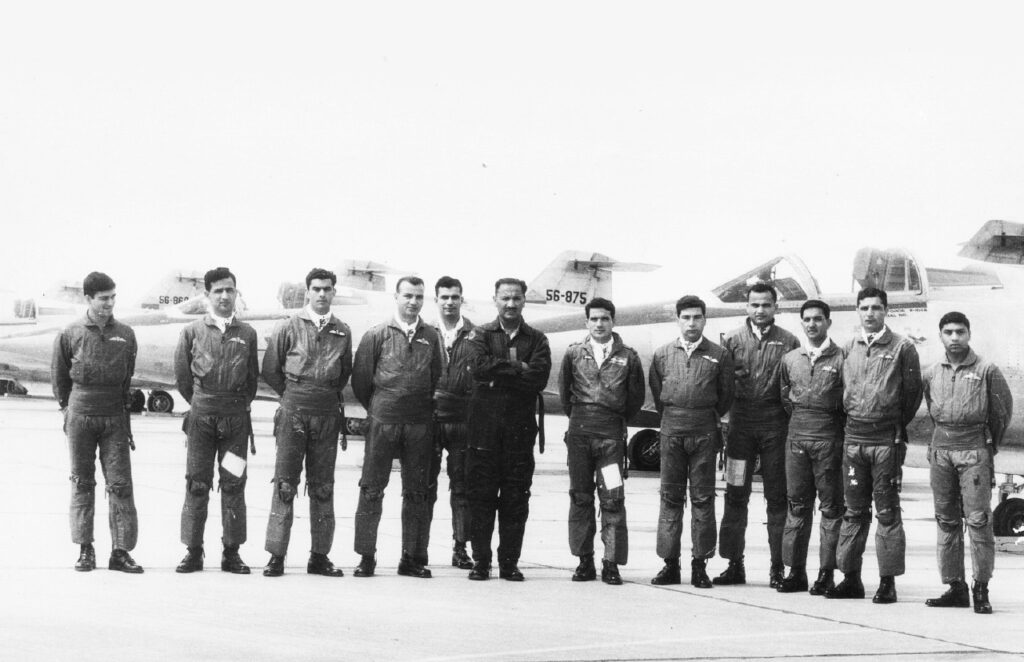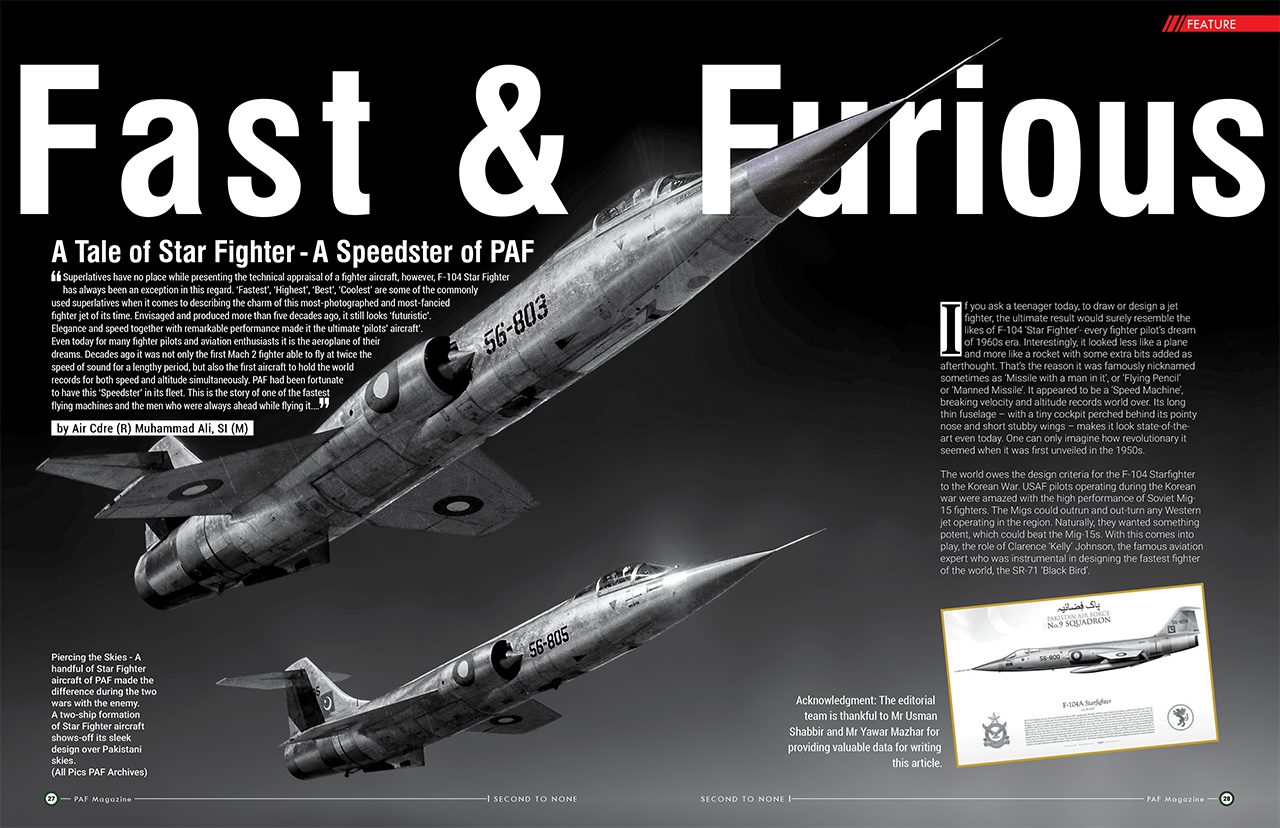Superlatives have no place while presenting the technical appraisal of a fighter aircraft, however, F-104 Star Fighter has always been an exception in this regard. ‘Fastest’, ‘Highest’, ‘Best’, ‘Coolest’ are some of the commonly used superlatives when it comes to describing the charm of this most-photographed and most-fancied fighter jet of its time. Envisaged and produced more than five decades ago, it still looks ‘futuristic’. Elegance and speed together with remarkable performance made it the ultimate ‘pilots’ aircraft’. Even today for many fighter pilots and aviation enthusiasts it is the aeroplane of their dreams. Decades ago it was not only the first Mach 2 fighter able to fly at twice the speed of sound for a lengthy period, but also the first aircraft to hold the world records for both speed and altitude simultaneously. PAF had been fortunate to have this ‘Speedster’ in its fleet. This is the story of one of the fastest flying machines and the men who were always ahead while flying it….
If you ask a teenager today, to draw or design a jet fighter, the ultimate result would surely resemble the likes of F-104 ‘Star Fighter’- every fighter pilot’s dream of 1960s era. Interestingly, it looked less like a plane and more like a rocket with some extra bits added as afterthought. That’s the reason it was famously nicknamed sometimes as ‘Missile with a man in it’, or ‘Flying Pencil’ or ‘Manned Missile’. It appeared to be a ‘Speed Machine’, breaking velocity and altitude records world over. Its long thin fuselage – with a tiny cockpit perched behind its pointy nose and short stubby wings – makes it look state-of-the-art even today. One can only imagine how revolutionary it seemed when it was first unveiled in the 1950s.
The world owes the design criteria for the F-104 Starfighter to the Korean War. USAF pilots operating during the Korean war were amazed with the high performance of Soviet Mig-15 fighters. The Migs could outrun and out-turn any Western jet operating in the region. Naturally, they wanted something potent, which could beat the Mig-15s. With this comes into play, the role of Clarence ‘Kelly’ Johnson, the famous aviation expert who was instrumental in designing the fastest fighter of the world, the SR-71 ‘Black Bird’.
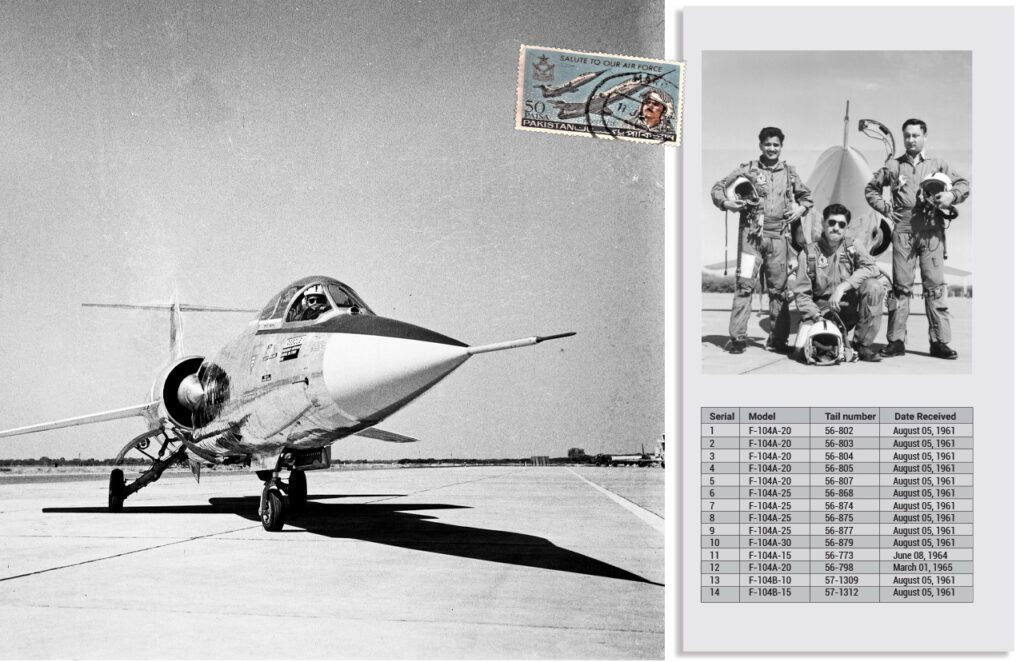
Johnson, with his team of experts, went out and met front-line US Air Force pilots during Korean war and asked them what they wanted in a next-generation fighter. The answers were hardly surprising….
“They wanted a lot more speed, altitude, and manoeuvrability,” says aviation historian Ray Panko, of the Pacific Aviation Museum. “The F-104 gave them the first two but sadly not the third.”
Clarence ‘Kelly’ Johnson’s Special Project team at Lockheed, refined a number of possible designs to find the best compromise between these conflicting requirements. The final design featured a long, thin body which housed a single turbojet, a thin un-swept wing of short (21ft 9in or 6.63m) span and a T-tail.
The F-104 first flew in March, 1954. It made an almost immediate impact. The needle-nosed jet quickly earned the nickname ‘the missile with a man in it’, however, its official name remained the ‘Starfighter’.
Arrival of Star (Fighter)
As the Soviet threat grew in the region in the 1950s, Pakistan aligned itself with the United States of America under the newly formed SEATO (South East Asian Treaty Organization) and the later British sponsored CENTO (Central Treaty Organization) security pacts. The treaties were signed to contain the former Soviet Union. This was the same time when PAF was fortunate to have a visionary leader like AM Asghar Khan at the helm of affairs. Taking advantage of the newly signed pact, AM Asghar Khan embarked upon a plan to modernise Pakistan Air Force based on the model of United States Air Force. Over the late 1950s and till the middle of 1960s, under the Mutual Assistance Program (MAP), PAF was equipped with American aircraft like the F-86 Sabre, T-33, T-37s, C-130s and B-57s, most important being the F-104. The Star Fighter, had by now stormed the world with its futuristic design and supersonic performance.
A total of 14 F-104 Starfighter aircraft were transferred to Pakistan, including 12 F-104A and two dual seat F-104B for training purposes. All the aircraft were ex-USAF Air Defence Command and were equipped with the 20 mm M61 Vulcan Gatling gun. It could also carry AIM-9B Sidewinder air-to-air missiles on wingtips. All aircraft delivered were also equipped with the C2 upward firing ejection seat and higher thrust General Electric J-79-GE-11A engines.
Pakistan was the first country in Asia to fly a Mach 2 aircraft. While most countries in Europe were flying subsonic planes and no country in Asia was flying aircraft of this class and technology, many questioned the PAF’s ability to maintain this advanced system. However, the PAF’s flying skills and technological competence were soon proven. The pilots and ground crew of No 9 Squadron, who had been handpicked from F-86 squadrons, became the envy of the PAF by gaining mastery of the aircraft. The performance of these dare devils in following years proved all the western critics ‘wrong’.
The first three pilots selected to undergo type conversion in the US included Sqn Ldr M Sadruddin, Flt Lt Mervyn Middlecoat, and Flt Lt Alauddin ‘Butch’ Ahmed. Sqn Ldr Sadruddin was sent to George AFB, California (east of Los Angeles) and spent time with 434 TFS, 479 TFW. This was part of “on the job” training as an executive officer for a squadron for 6-7 months. Towards the end of the stay he transitioned to F-104s and flew about 22 hrs on the aircraft during his training. Sqn Ldr Sadruddin also became the first Pakistani to push the Star Fighter to Mach 2. The other two pilots went to an Air National Guard unit in South Carolina for type conversion. The fully assembled aircraft were shipped to Pakistan, arriving at Karachi harbour in August 1961. The cargo reached Karachi harbour on board the USS Carrier CORE.
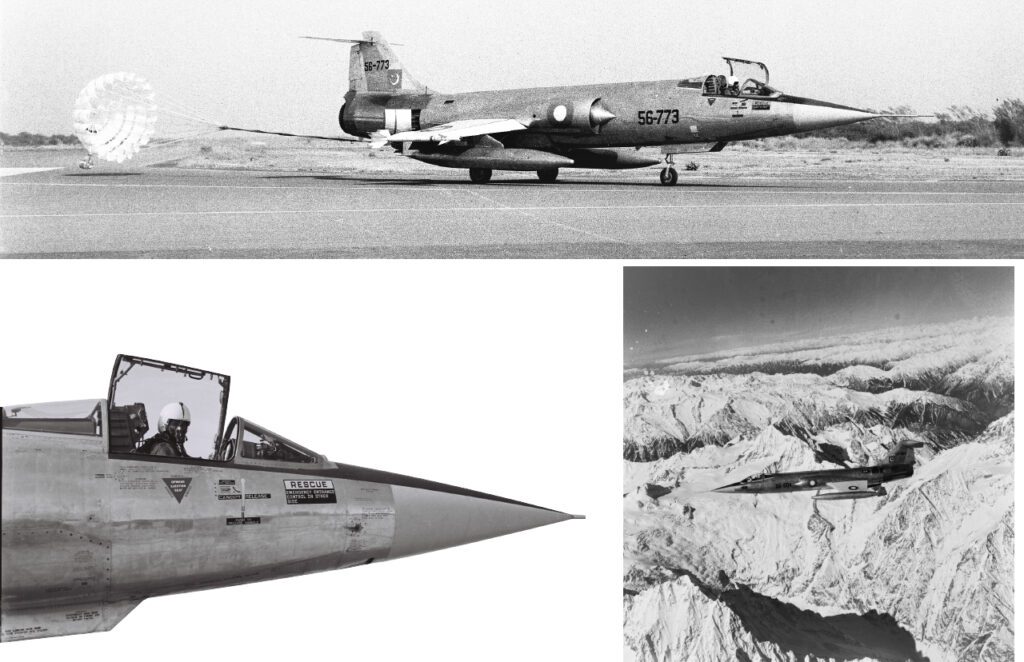
Before these newly delivered Star Fighters could scream through Pakistani skies, they had to undergo a mundane journey. These supersonic jets were towed by tractors, from the sea port, through the streets of Karachi to PAF Station Drigh Road (now called PAF Base Faisal) at 3-5 mph during the night. Pilots sat in the cockpits to apply aircraft brakes if necessary. It was an exciting journey, especially for the general public to witness. Upon arrival at Faisal, the aircraft were assembled and were air tested.
15 September 1961 would always be remembered as the red letter day in the history of PAF. Sqn Ldr Saddrudin (leader) and Flt Lt Middlecoat (No 2) flew the first pair of Star Fighters from Faisal to Sargodha (now PAF Base Mushaf). When the pair landed at around 1030 hrs, officers, airmen and families lined up on the tarmac to catch their first glance of the shining Star Fighters. It was a historic movement.
After arrival at Sargodha these aircraft re-equipped PAF’s No 9 Squadron, Griffins. Sqn Ldr M Sadruddin took over as the squadron commander with Flt Lt Alaudin Ahmed as his flight commander. Other early joiners included Flt Lt Jamal A Khan, Flg Off Farooq F Khan, Flt Lt Hakimullah, Flg Off M M Khalid, Flt Lt Arif Iqbal, Flt Lt Hashmi, Flg Off Amjad Hussain and Flg Off M Akbar.
That PAF senior commanders literally led from the front was demonstrated by the fact that then C-in-C Air Marshal Asghar Khan and some other senior officers attended the relevant ground school and undertook a number of familiarization flights on the aircraft. The conversion course included 2-3 weeks of academic classes followed by a few rides in F-104Bs and final check rides in a single seater. Once the pilot was qualified, an initial training period of 40-50 sorties commenced. This included navigation, formation flying, gunnery, air combat manoeuvring and interceptions.
A Manned Missile
F-104’s clean profile meant quick acceleration on take-off. Pilots had to be quick with retracting under-carriage as the maximum allowed speed of 240 knots for undercarriages down was reached quickly. That the gears retracted within 3 seconds of selection, was another small but impressive feature of the aircraft. In case the pilot did exceed the maximum allowable velocity for gear down, he then had to enter a steep climb to bleed speed and reach the 240-knot figure.
“To say that the wing was ‘thin’ was an understatement. It had a maximum thickness of 4.2in (10.7cm) and its leading edge was so sharp that protective strips had to be fitted to avoid injury to ground crew. The wings offered no room for stowage, so the fuselage had to contain the retracted undercarriage and all the fuel tanks,” recalls AVM Amjad Hussain (Retd).
Starfighter’s thin wing aerofoil and high wing loading left little room for mistakes at low speed. It had to be landed at a minimum 150 knots IAS (with engine RPM at 88-90%). Other impressive features included the powerful M61 Vulcan cannon. It fired 20mm shells at the rate of 66 per seconds, totally a monster.
Going Super Sonic
The aircraft’s sheer power and, if one could ascribe it a personality, was best illustrated by the mission profile for going to Mach 2. “The first requirement for such a mission was to find out where the tropopause was on a particular day. This was important as the aircraft acceleration is quickest at this altitude. Once the tropopause had been determined the sortie could begin,” narrates AVM Amjad Hussain (Retd) while talking to the author. The configuration for going Mach 2 meant a clean aircraft, without external tanks or air to air missiles.
A standard subsonic climb at Mach 0.9 to the tropopause (generally around 37, 000 to 40,000 feet in summer) was made. After levelling off and getting into the transonic regime at Mach 0.9 and level flight, full afterburner was selected and the acceleration to Mach 2 began. The acceleration was quite rapid and going supersonic took only a few seconds. It was hardly noticeable except for a quick flick of the Machmeter from 0.98 to 2. Upon attaining Mach 2 the procedure for slowing down had to commence immediately or the airplane could accelerate well beyond Mach 2!!!.
The First Test-1965 War
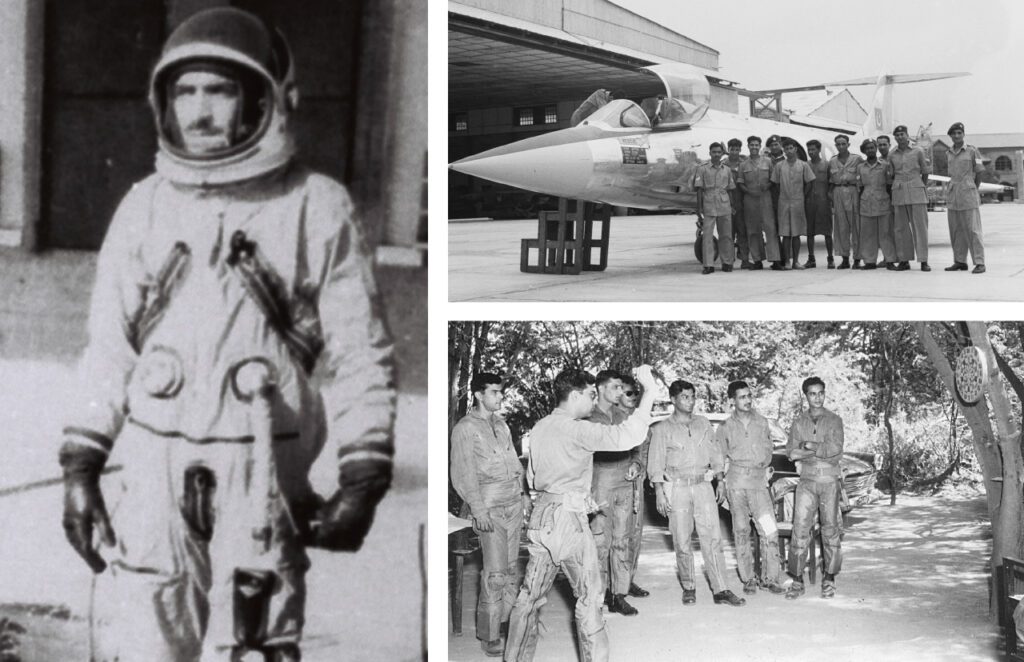
As tensions between the two regional rivals worsened into armed conflict over the Rann-of-Kutch dispute in April 1965, a detachment of two F-104s was immediately sent to PAF Station Mauripur (now PAF Base Masroor) to reinforce the existing F-86F and B-57 squadrons. This was the first time PAF’s F-104s saw operational duties during a conflict situation. Full scale hostilities broke on 6th September, 1965, with F-104s tasked for air defence duties. The honour of achieving the first kill with the outbreak of declared war also belongs to a Star Fighter. It was on an early morning CAP on that day when Flt Lt Aftab Alam (later retired as Wg Cdr), encountered a formation of four IAF Mystere aircraft, which was attacking a passenger train near Rahwali. Vectored to the location by Flt Lt Farooq Haider from Sakesar radar, Aftab Alam dashed head-on through the centre of Mystere formation at supersonic speed, leaving the enemy in disarray. In the ensuing combat at treetop level, Aftab outmanoeuvred the opponents to claim an IAF Mystere with an AIM-9B Sidewinder and damaging the other with his lethal Vulcan Gatling gun. The remaining two managed to run away to safety, only to tell the tale of “dreaded F-104 and its deadly Sidewinder”. Apart from being the first encounter to commence the war in earnest, the engagement was also significant in other respects. It marked a new era of dog-fighting at almost treetop level. Not only was it the first combat kill by any Mach-2 aircraft in the world but was also the first missile kill for the PAF.
The result was obvious, IAF was devastated. It wanted revenge the next day. However, the dream of taking revenge turned out to be a nightmare for them. The first IAF air strikes on PAF bases took place on the morning of 7th September, 1965. It was at 0530 hrs that the first IAF strike on PAF’s Sargodha air base was detected when the formation of 6 IAF Mysteres was already pulling-up to attack the airfield. Airborne Flt Lt Amjad Hussain Khan (later retired as AVM) in a F-104A was vectored by ground control to intercept the raid. Flying at supersonic speeds, Amjad claimed one Mystere with his deadly AIM-9B and the other one with his cannons. In the melee, Amjad’s aircraft went through the debris of exploding enemy aircraft. He ejected safely and made it back to Sargodha air base on a bicycle, a horse and was picked up in a helicopter!!!
End of Night Intruders
Star Fighter’s rate of climb was exceptional. It was designed to catch up with enemy aircraft before they could release their weapons – a role known as ‘interceptor’ – which meant it needed to reach its targets quickly. A Starfighter pilot could reach 48,000ft (15 kilometres) in one minute, a feat still impressive. The Starfighter would fly fast and straight, firing its missiles from many miles away, and turning back to base before its target had time to respond. This capability was put to good use by PAF during the 1965 war while intercepting the IAF Canberras. PAF’s tactics during the war included single or pairs of Starfighters providing top-cover to CAPS of F-86s. In addition, F-104’s radar based fire control system meant that it was the only fighter in PAF’s inventory which could take up the role of a night interceptor against IAF Canberra.
The first positive contact between an F-104 and a Canberra took place on the night of 13th September, when Sqn Ldr Middlecoat (later attained Shahadat during 1971 war with award of SJ with bar) fired a Sidewinder on a Canberra in a blind intercept. An explosion was seen at a range of 4,000 ft but no confirmation was possible as the encounter took place over Indian territory. Later, reports revealed that the aircraft was destroyed. However, a confirmed kill was obtained on the night of 21st September, when Sqn Ldr Jamal A Khan (later became CAS PAF) made radar intercept of an egressing Canberra and shot it down with an AIM-9B Sidewinder. In this particular case the IAF Canberra climbed earlier than usual due to fuel considerations and failed to switch on its tail warning radar on ascent. Sqn Ldr Jamal saw an opportunity and shot the night intruder down with his lethal sidewinder missile. The pilot ejected and was captured by Pakistani forces.
Catch Me if You Can!
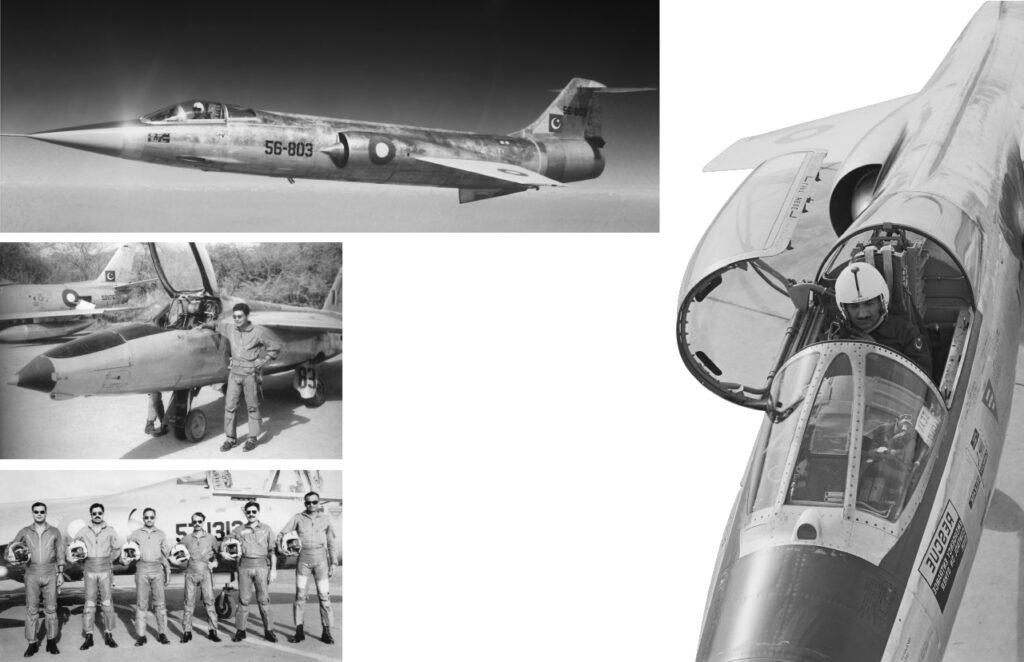
Perhaps the most interesting event of the war were the ‘super sonic boom’ missions carried out by the ‘Speedster’ over Amritsar airfield. AM Nur Khan, being the visionary C-in-C asked Flt Lt Farooq Umer (later retired as AVM) to perform a low level super sonic boom at Amritsar. The idea was to harass the enemy in the opening round of the war and also to prove the lethality of F-104 aircraft. He succeeded in both. On that fateful day, Flt Lt Farooq Umer flew two supersonic passes over Amritsar. Immediately after the first pass he was asked to repeat the heroics for one more time. However, this time the Indian guns were ready and they had provided an umbrella of ack ack fire but they were of no match to the supersonic flight of the Star Fighter. Faroor Umer remembers, “The sky was red and there was no way, it appeared, that any aircraft could get through, yet I was not deterred and went through the mountain of the ack ack fire for the second time. By the time I landed back, All India Radio came up with interesting stories. It narrated that eight F-86 aircraft attacked and had rocketed/bombed the Amritsar airfield.” The mission thus succeeded in achieving psy ops by creating confusion among the enemy ranks.
Reconnaissance Role
PAF’s reconnaissance fleet consisted of RT-33 aircraft, which were ill-suited for any recce missions in a high threat area. Therefore F-104s were used to escort any such recce missions and a pair of F-104s had to criss-cross the slower RT-33 to maintain formation. On at least one such mission the PAF formation came across an IAF Hunter formation, which appeared to be returning to base. The IAF Hunter formation promptly scattered, and the PAF F-104s being deep into Indian Territory with an RT-33 to escort, decided not to pursue. An innovative solution to the recce problem was found when two seater F-104Bs were used as recce birds with the pilot in the back seat holding a hand held camera. The F-104B would fly extremely low, pulling up slightly near the target airbase and going inverted, allowing the pilot in the back seat to get a better view for recce photos.
Nick Named ‘Badmash’
IAF had nicknamed the Starfighters as “Badmash” (meaning scoundrel) out of respect and dread it had for the aircraft. “During the 1965 war, the F-104 pilots noted that whenever they got airborne, the IAF grounded all its aircraft. It frustrated us,” remembers Wg Cdr Aftab Alam (Retd) during an interview with the author.
“My brother Flt Lt Mushtaq, flying an F-104 in the same squadron with me made contact with the enemy, only to note the IAF Hunters disengaged well in time. Flt Lt “Micky” Abbas in a F-104 had a similar episode. This experience would be repeated for the F-104 pilots for all daytime interceptions. I personally patrolled in a lone F-104, at 30,000ft, deep inside Indian territory, over the two Indian fighter airfields of Adampur and Halwara for one hour. The Indians did not respond. This was total air superiority for PAF, and it displayed the supremacy of the Starfighter as well,” reminisces Wg Cdr Aftab Alam (Retd). The star fighter became a nightmare for IAF pilots. The following episode would adequately summarise this claim.
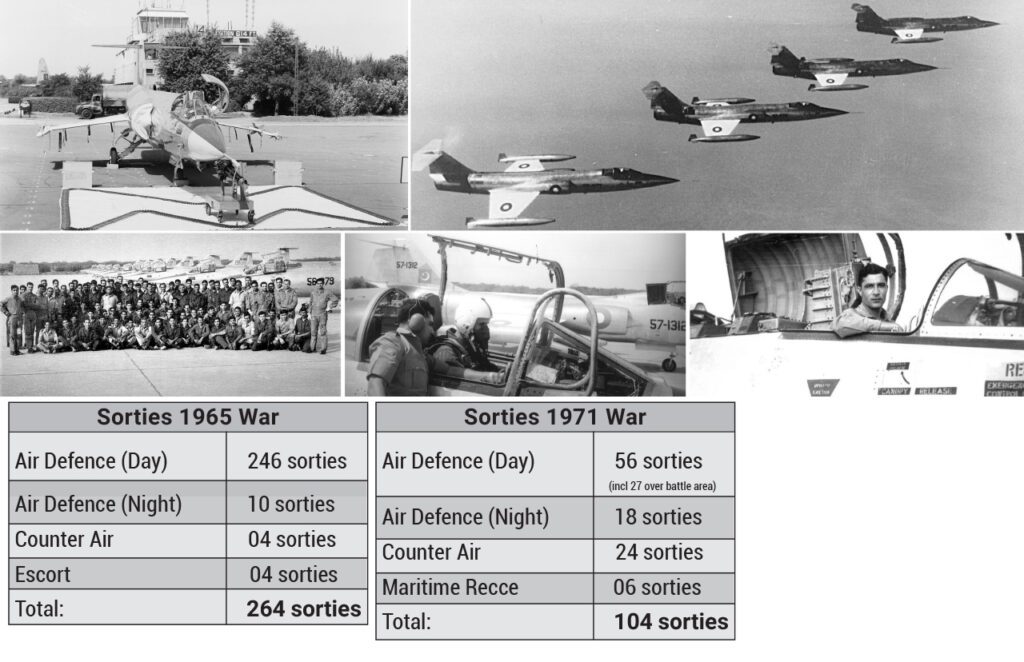
On 3rd September, 1965 a CAP of two PAF Sabres was bounced by six IAF Gnats with PAF air defence controller scrambling an F-104 flown by Flg Off Abbas Mirza to the aid of the Sabres. The IAF Gnats scattered on sighting the charging Starfighter, “Pajh oye … 104 ayaeeee” is how Sqn Ldr Brij Pal Singh announced the arrival of the Starfighter. Roughly translated in English it means ‘run…it’s a 104’. But as translations go it misses the point and only a Punjabi speaker can understand the sheer panic and loss of composure of this call. In the meantime another F-104 was vectored to aid the fight. By the time, Flt Lt Hakimullah (later retired as ACM) arrived, the Gnats had already split. Perhaps mixing this Starfighter with the first one or realising that there are now two F-104s, Sqn Ldr Brij Pal Singh concluded that safely egressing to India was not possible against the supersonic Starfighter. Ultimately, he lowered his gears as a sign of surrender and landed at a nearby disused airfield at Pasrur in Pakistan. The surrendered Gnat continues to serve as a war trophy at the PAF Museum at Karachi.
At medium and high altitudes the F-104 ruled the sky. The IAF refused to challenge the Starfighter. However, below 5,000ft a fierce battle raged between the F-86 and the IAF fighters, mainly the Hunters and Gnats. The F-86 was the workhorse of the PAF, it was under-powered, outnumbered, and out-gunned. Nevertheless the F-86 pilots showed courage, fearlessly engaging their opponents, and displayed an unusual skill for air combat, achieving an excellent kill ratio. Important thing was the F-104 controlling the sky at medium and high altitude, had reduced the workload for the F-86’s to the extent that the numbers were manageable. The F-86’s could now hold their own against the enemy at low altitude. The F-104/F-86 lethal duo had won the air battle for the country. From day one of war, PAF had fully established air superiority, thanks to the scare created by the handful of star fighters. “The job had been done; later the numbers did not matter much. The will of the enemy to fight the F-104 had been broken. The Starfighter reigned supreme. lt had played a vital role for the defence of Pakistan and the supremacy of the PAF”, concludes Wg Cdr Aftab Alam (Retd).
Modifications
Resultantly, during 1968-69, at least one of the two F-104Bs was modified to carry Swedish made reconnaissance cameras (TA7M) in the rear seat. There were three cameras in one set of equipment, two oblique cameras and one vertical. The vertical camera was installed in the centre and oblique cameras fixed on either side of the vertical camera for a total photo coverage angle of 170 degrees. This gave the F-104B the capability to look deep inside the enemy territory from a safe distance with coverage area depending on the height at which the aircraft would be flying. This modification flew quite a few trial missions before the 1971 war and the results were encouraging. Another important modification was installation of radar homing device on a single F-104A aircraft. This device called SLARD (Short range Low Altitude Radar Detection) and alternately Radar Locator (RALOR) was sourced through an American source and initial trials were carried on a twin engine communication plane. Based on results of such trials it was decided to fit an F-104A aircraft with this equipment.
Assistance to Royal Jordanian Air Force
In 1968 Royal Jordanian Air Force (RJAF) had inducted F-104 A&B Starfighter aircraft and a request was made to Pakistan Air Force to convert RJAF pilots on the aircraft along with leading some pilots to Instructor Pilot status. This started PAF’s association with Jordanian F-104s. As the RJAF Starfighters started arriving at Prince Hassan Air Base (H-5) in USAF cargo airplanes and were being assembled and test flown by test pilots from Lockheed Martin, PAF aviators deputed to RJAF started the pilot conversion program. Standard operating procedures, Flight Orders, check lists, flying syllabus, boards and charts, and all other operational aspects that were required for the establishment of fighter squadron, were produced.Initially 15 pilots were converted, including Major Ihsan Shurdom who later rose to command the RJAF. King Hussain of Jordan, himself a keen aviator, was a regular visitor to the F-104 squadron. This association with RJAF turned out to be useful during testing times for the country later, during the 1971 war.
The Second Test-1971 War
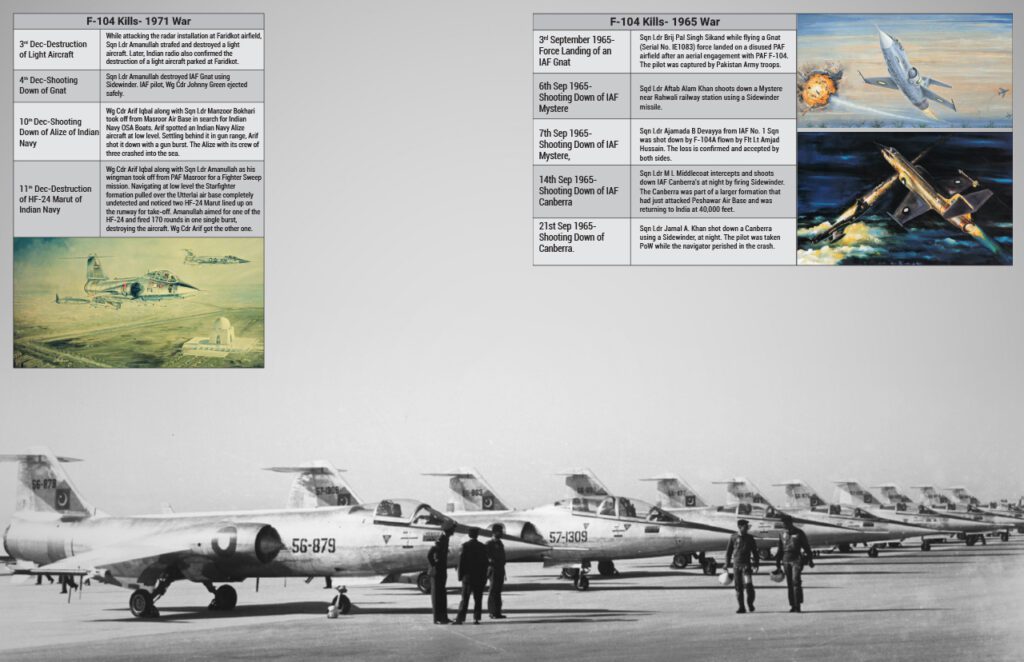
As India-Pakistan tensions mounted around mid-1971, a number of pilots with previous F-104 experience were sent to Jordan for regaining currency on the aircraft. Pilots returning from Jordan were reposted to PAF’s No 9 squadron. In Jordan, PAF pilots could also undertake Dissimilar Air Combat Training (DACT) with Jordanian Hunters (given the significant presence of the type with IAF). When war broke out in the first week of December, some pilots were still in Jordan and had to hurry back. Wg Cdr Middlecoat was one of the notables who rushed home and joined No 9 Sqn stationed at Masroor. Later, he embraced Shahadat while attacking an IAF airfield and was awarded with Bar to SJ after the war.
With outbreak of hostilities on 3rd December, PAF carried out pre-emptive strikes on forward Indian air force bases and radar units. As part of these pre-emptive strikes, No 9 Squadron was tasked to attack Amritsar, Faridkot and Bernala radar stations. Wg Cdr Arif Iqbal (OC No 9 Sqn), Sqn Ldr Amanullah, Sqn Ldr Amjad Hussain along with Sqn Ldr Bhatti played a key role in neutralising Indian radar stations in the opening round of the war. During one of these missions on 5th December, Sqn Ldr Amjad’s aircraft (Tail No 56-804) was hit by anti-aircraft guns deployed around the radar station. He turned towards Pakistan, hoping to recover when his wingman gave an ejection call, confirming that fire was spreading. Amjad ejected and was taken POW.
Friends Join In
On 6th of December No 9 squadron was ordered to move to PAF Base Masroor, Karachi. For the rest of the war the squadron performed day and night Air Defence and Counter Air Operations from this base. It was at PAF base Masroor that the squadron received F-104s provided by the Kingdom of Jordan in support of Pakistan during the 1971 war. On 13th December, when the Jordanian No 9 Squadron pilots were about 200 miles out from Karachi, a PAF Starfighter formation led by Sqn Ldr Amanullah got airborne to escort them to Masroor as they were unarmed. Sqn Ldr Amanullah was in formation with Major Ihsan Shurdom and Awni Bilal to guide them for landing at Masroor while orbiting overhead providing top cover.
The Final Salute
F-104s life in PAF was cut short by the US governments so called ‘even-handed’ arms embargo on both Pakistan and India after the two wars. The sanctions did not bother Indians much as they were hardly using any US military equipment. However, the embargo had a devastating impact on the PAF operations. In the face of growing difficulties in procuring spares for the US equipment, especially F-104s, PAF leadership ultimately decided to phase out the ‘Star Fighters’ in mid 1972.
A pair of F-104s lifts off from PAF Base Masroor on a humid afternoon of 21 June 1972, for a farewell flight, after serving the PAF for more than eleven eventful years including startling performance during two wars. Many heavy hearted pilots, technicians, families and enthusiasts witnessed the last flight. The honour of flying the last mission went to Sqn Ldr M Amanullah and Flt Lt Abbass H Mirza from No 9 Sqn. This ended the memorable story of PAF and its love with an engineering marvel, remembered by many as a “missile with a man in it”.
“Yes, it was demanding to fly with a wingspan of just 21 ft 9 in. It had the engine-out glide ratio of the proverbial ‘flying brick’ – and nobody ever accused it of being manoeuvrable. But the Star fighter went fast, climbed like a homesick angel and introduced pilots of many nations to the joys of Mach 2 flight. Fighter pilots around the world loved the Star fighter’s out-and-out performance and the type enjoyed mystique unmatched by any other ‘Century Series’ fighter”, concludes one of the pilots of this amazing machine- ‘The Speedster’.
